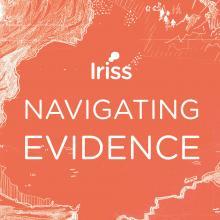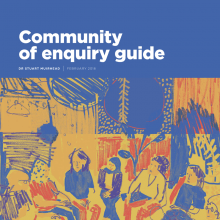This collection of 13 papers details the evidence into action scoping methodology developed through pilots with social work and social care teams in three health and social care partnerships in Scotland. It summarises the learning from the pilots and highlights key considerations for applying and further developing this methodology in the future. The themes for the pilots included domestic abuse, mental health and palliative care.
The work within the collection aimed to do a number of things:
- Develop and test a methodology that combines the use of published research, improvement evidence and practitioner knowledge
- Further subject knowledge and develop action plans within the three pilot areas
- Contribute knowledge towards the future development of an evidence search and summary service for the social services sector in Scotland
We hope that the collection may be useful to both those who are working in the subject specific priority areas that were the focus of the pilot studies, as well as those interested in the application, process and methods employed in using evidence to make service changes.
Each of the papers can be downloaded individually from the list at the bottom of this page, or you can download the full set of all 13 PDFs here.
Overview of the collection
This project was conducted to support implementation of the Improving Use of Evidence action area within the national Shared Vision and Strategy for Social Services in Scotland 2015-2020. It aimed to recognise the value that social services place on evidence from experience and context as well as from research. The intention was to define a methodology that would bring together these different types of evidence and support social work and social care staff to convert that evidence into decisions and actions.
To develop and test this methodology, pilots were identified in three health and social care partnerships, each focused on a different priority area for transformational change. These were:
- Developing the role of homecare workers in palliative and end of life care (Edinburgh City Council)
- Improving multi-agency communication in working with domestic abuse in families with children (Dumfries and Galloway)
- Developing the role of the social worker in first-tier prevention of mental health issues in children and young people (East Dunbartonshire)
Stages of the work
There were a number of stages employed when working in each of the three areas:
- Engage project owners in each area and define the area of enquiry
- Source and summarise published research evidence
- Source and summarise evidence from practice
- Source and summarise evidence from improvement
- Collate information and learning resources and produce an overall summary
- Facilitate an action planning workshop in each area
- Project owners take responsibility for the developed action plan
The outputs from each of the pilots were comprised of reports around three main evidence bases:
- Evidence from published research
This was evidence predominantly consisting of work from the peer-reviewed academic literature base - Evidence from improvement knowledge
For this project, improvement evidence was defined as real-life examples of improvement, recommendations for service improvement, evaluation reports, practice development and piloting / scoping initiatives. These were often case studies or examples from grey and more tacit knowledge areas. - Evidence from practitioner knowledge
This evidence was collated by hosting focus groups and interviews with practitioners and partners working within the pilot study areas and contexts.
These three evidence bases were then used to compile a combined summary of evidence for each pilot area. Following this work an action plan was developed during workshops with each of the pilot areas. All the pilot area evidence reports can all be found on this page, as well as a full summary and learning paper of the project.
Learning from the work
The full summary and learning from the work can be found in the overall summary report titled Exploring the three-pronged scoping methodology: Summary of findings and potential for the future. Below is some of the combined learning from that full paper.
1. The three-pronged method – combining published literature, improvement knowledge and practitioner knowledge
Each of the pilot areas found the provision of the published evidence and improvement knowledge summaries useful in giving them a clear evidence base to inform their decision-making. This was complemented by engaging and speaking to practitioners embedded in their local and professional contexts. The incorporation of these three evidence bases was particularly valued in that it was able to provide a more in-depth and practical perspective that gave the pilot areas a stronger basis to argue for, and make, appropriate changes to their work and services.
2. Balancing knowledge from different contexts
In each of the pilots, there was often little in the way of direct and appropriate published evidence that could be used to inform decision-making. This limitation was particularly apparent for the enquiries about the homecare worker role in palliative care, and the social worker role in preventing mental health risks. In a sector where new roles, contexts and challenges are emerging, this will often be the case. Similarly, although the improvement evidence was extremely useful in helping the areas understand how others have tried and implemented changes from similar contexts, there was often a limited amount of comparable pieces of work that could be found. In the pilots, the presence of a knowledgeable practitioner voice, as articulated through interviews and focus groups, tended to have a stronger impact on decision-makers than the academic research and helped to drive the recognition of the need to change.
3. Going from evidence to action
The scoping methodology could only go as far in the pilot areas as developing an action plan that was informed by the evidence summaries. It was then the responsibility of the owners in the pilot areas to take these action plans forward, having identified outcomes that they wanted to achieve in the short, medium and long-term. This is often the case in an evidence methodology such as this that relies strongly on being informed, led and delivered by local knowledge and context. What helped the pilot areas, was that the summaries of the three evidence reports highlighted challenges and ways these could possibly be addressed. These were then used to inform and direct the workshops held in the areas and provided a basis for them to go on and develop their action plan.
To help with that thinking, three categories were used across the summaries around areas for potential actions. These were: 1) Information and knowledge support; 2) Learning and development; 3) Service improvement opportunities. These seemed to be broad enough starting points and categories to start thinking about potential actions to take. The overall process of moving into the action stage also highlighted the importance of identifying ‘quick wins’ to maintain momentum and enthusiasm for the work. As with all change plans, there had to buy-in and support from senior management and leaders and a framing of the actions within wider strategic and policy contexts.
4. Time and commitment
Finally, the process took time and commitment, from those involved within the evidence search and summary service, and those within the pilot areas. This commitment had to be formed at the beginning, in the development of the enquiry, but also in terms of following the work through to the action stages. The pilot work for this methodology suggests that there will be around five to six months from initial enquiry formation, to beginning to deliver an action plan. This entails three to four weeks worth of total work for an evidence specialist to deliver one of the pilot projects. This encompasses connecting with the owners of the work, collating and publishing the improvement and published evidence summaries, designing and carrying out the practitioner evidence collation, facilitating and running an action workshop, and writing up an action plan. Throughout that time it is imperative to continue momentum and have the pilot area owners involved in the stages of the work and leading on bringing in other appropriate partners and collaborators.
The full summary report goes into more detail around the learning from each of the stages of the process, and makes more focussed service recommendations based on the challenges and opportunities that the pilots presented in designing and delivering an evidence search and summary service that can lead to meaningful change.
Project management and legacy
The project was managed by the Evidence Search and Summary Service, originally located within NES. This service identified project owners and topic areas of interest within the three local authority areas. It produced two of the three research evidence summaries for these enquiries and one of the improvement evidence summaries. After NES’ decision in January 2017 not to continue to support this service, the projects continued to be managed by the senior lead originally in charge of that service, who was located in the Scottish Government Digital Health and Care team. An external research consultancy (SMCI Associates) was engaged to conduct the interviews and focus groups to gather practice-based evidence, and to produce the outstanding summaries of evidence from published research and improvement.
Learning from the work, around the content of summaries as well as the engagement with practitioners, was used to inform the development and delivery of the current Iriss Evidence Search and Summary Service (ESSS) that helps social services practitioners find and use evidence to inform service improvement and continuous learning. Crucially, the Iriss ESSS provides practitioners with evidence from research, practice and experience contexts, while working with them at the beginning to focus and define their enquiry question. This service was launched in late-2017, following completion of the NES service, and there have been 25 summary Outlines published in that time, responding to enquiries from across the sector. As well as being used to inform the owners of the original enquiry, all ESSS Outlines are published online so they can be accessible to others.




